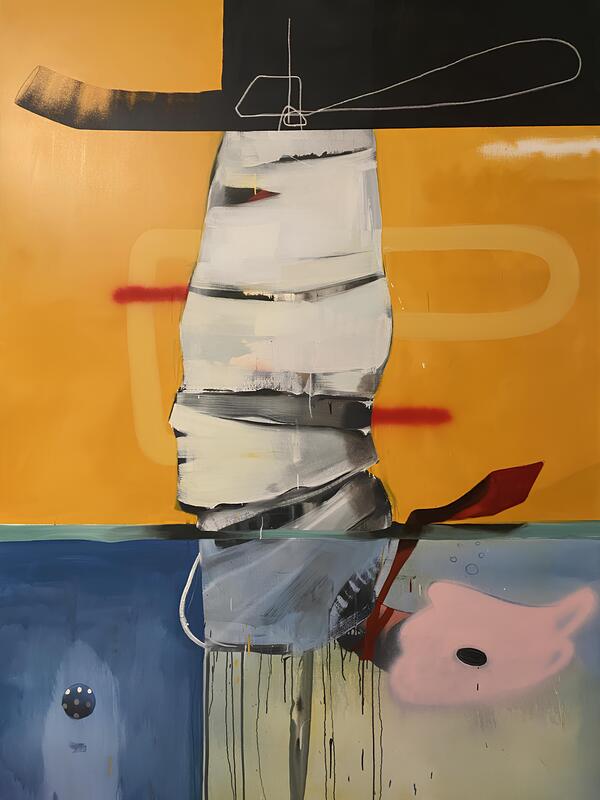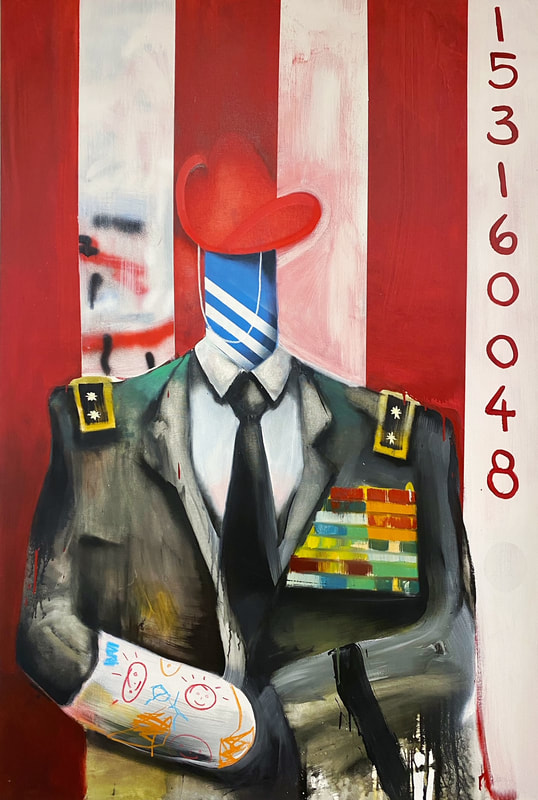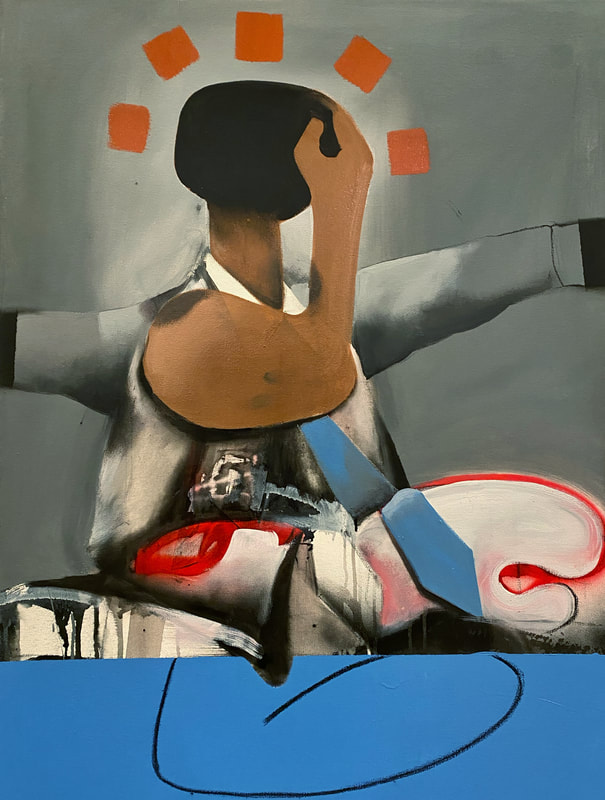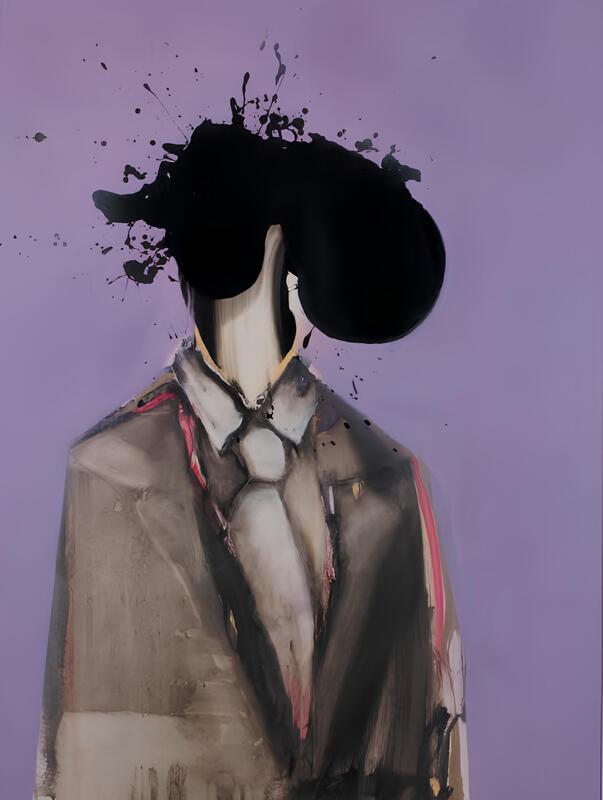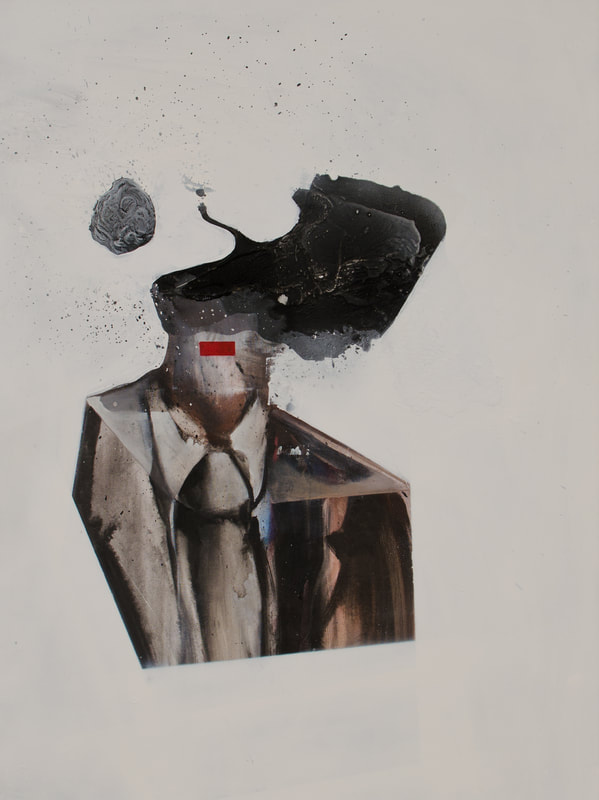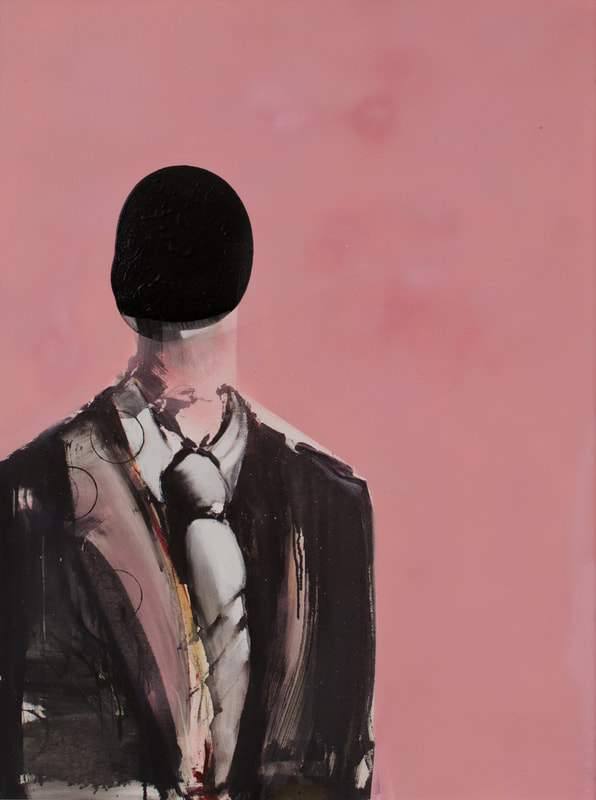"I started exploring power structures and how business in capitalism merges with culture. The first ones were created at the end of 2011 and were inspired by a painting I did titled, "Ratrace," showing three different ethnically depicted faceless businessmen in a particular hierarchical sequence. "
- Marcus Jansen, 2012
|
FACELESS SERIES
2011 - 2024 Art SWFL by Tom Hall, 2012 In 2012, Jansen launched a new series that he named "Faceless." The series is a departure from Jansen’s post-apocalyptic dystopian urban environments. Jansen wanted to experiment with classical portraiture but felt that the genre was a little too staid for his tastes. Whereas traditional portraiture focuses upon a visual depiction of the subject (such as the Mona Lisa or Henry VIII), Jansen’s brand of portraiture is premised upon the supremacy of the painter’s artistic feeling about the subject. So in Faceless, Jansen has created a macabre metaphorical gallery of the faceless corporate power brokers who make decisions that affect our world behind the anonymity of corporate board rooms – whether on Wall Street or somewhere in the world of business. And in the tradition of Russian Suprematist Kazimir Malevich, Jansen expresses his internal reaction through basic geometric forms such as circles, squares, lines and rectangles painted in a limited range of monochromatic colors. Works from Faceless were also included in Anonymous, a group exhibition by 34 artists from around the globe that opened November 22, 2012 at Russia’s PERMM Museum of Contemporary Art . Anonymous explores the theme of anonymity, not just in modern art, but in business, government and a social fabric increasingly dominated social media, the blogosphere and Internet marketing. The exhibition reflected in particular upon the motives and semantics of anonymity in modern art through displays that addressed topics ranging from modalities that provide protection against adverse reactions by corporate and government authorities to new forms of portraiture that reject the traditional stylized rules that have governed the genre from the Byzantine era to the present day. Jansen’s new Faceless Series falls within the latter grouping. Incident to the exhibit, the PERMM Museum of Contemporary Art purchased Jansen’s Faceless #3 (left). The PERMM acquisition was made by its chief curator, Marat Guelman, who is widely regarded as one of the top judges of artistic talent in Russia. His assessment of Jansen’s talent corroborates commissions by Ford Motor Company, Warner Brothers and Absolut Vodka, which invited Jansen to participate in their ABSOLUT BLANK global marketing campaign in 2011 along with 17 other internationally-acclaimed artists. |
CHOAS MAGAZINE by Lauren Hostetter, 2012 Underneath a swelling torrent of social media platforms like Twitter, Instagram, and Facebook, it would seem that we’ve forgotten the value of anonymity. In an attempt to fill our 500+ acquaintances in on the gritty and incredibly interesting details of our daily lives, we willingly provide our precise geographic coordinates when trying out a new restaurant and share faux-polaroid glamour shots of questionable artistic merit. We’ve convinced ourselves that power lies in celebrity, when in fact it lies with a total lack thereof. The anonymous figure gets to say and do just as he pleases and, so long as he has no name and no distinctive characteristics, avoids any potential backlash with ease. Anonymity and its consequences, both good and bad, are at the forefront of Anonymous, an exhibit that opened up just last Friday at the Perm Museum of Contemporary Art (PERMM) in Perm, Russia. Florida artist Marcus Jansen, who is considered by many to be the 21st century’s response to artists like Jackson Pollock and Robert Rauschenberg, will be representing the United States with a series of paintings called “Faceless.” The “Faceless” paintings all depict men in suits and ties, with faces blotted out and smeared to varying degrees, and in one instance removed entirely to reveal the iconic Hollywood sign on the horizon. Some appear to explode violently, while others are obliterated with the equivalent of a massive thumbprint, but two things remain the same throughout the series: these are all men of power, and we have no idea who they are. Their power lies partially in their dress, but also in their lack of discernible identity. Like the British Bankers’ Association and its anonymous committee members, who make major decisions regarding the global economy, their benevolence is much appreciated while it lasts. But once the proverbial shit hits the fan, they can flee unscathed and unnamed while we stand by pointing fingers in the general direction of the scandal. In addition to Jansen, 33 other artists from Russia and neighboring areas are represented by over 100 pieces of art. Among those showing in the exhibition are Oleg Tselkov, Grisha Bruskin, Sergei Shutov, Erbol Meldibekov Richard Vasco, Michal Rovner, and D. Bratza. Artist Lusine Dzhanyan reenacts in miniature Pussy Riot’s now infamous 2012 performance at Moscow’s Russian Orthodox Church, and photographer Katerina Smirnova creates incognito portraits of strangers as a commentary on the false personae we create when we engage in social networking activities. Faceless works were first published in the Marcus Jansen DECADE book with a foreword by Art Histrion Jerome A. Donson, Director of the American Vanguard Exhibitions Europe, 1961. |
Ratrace, 30x40" oil on canvas, 2000 - The first face distorted work
Published in the book, Marcus Antonius Jansen, Modern - Urban Expressionism published in 2006 |
“In many museums you can walk through and see Colonialists depicted on a pedestal in high regard. Next to them are usually classical landscape paintings that have historically been used to project power. In my paintings,
these portraits are usually unveiled and stripped of power and the landscapes are often areas of mystery, questions and conflict.”
- Marcus Jansen, 2022
2015 - 2024
2011 - 2015


